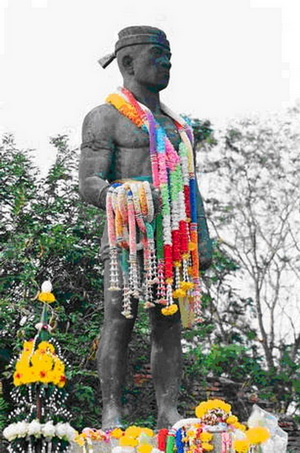Nai Khanomtom Day

The Legend of Nai Khanom Tom
The ancient capital of Ayutthaya is home to the annual World Thai Martial Arts Festival and Wai Khru Muay Thai Ceremony. For individuals trained in the ancient Thai art of boxing or ‘Muay Thai’, the annual Wai Khru Muay Thai Ceremony held during the annual Thai Martial Arts Festival is the most important date on their calendar. Muay Thai boxers from around the world return to Ayutthaya to pay respect to their teachers, and to pay homage to the legendary Muay Thai folk hero, Nai Khanom Tom.
Formally known as Phra Nakhon Si Ayutthaya, the ancient city of Ayutthaya, was founded in 1350 by King U-Thong and remained the capital city of the Kingdom of Siam for 417 years, from 1350 to 1767. During this time, 33 kings of various Siamese dynasties have reigned in Ayutthaya, each contributing to the Kingdom's many cultural treasures. At its height of glory, Ayutthaya was one of Asia's most prosperous cities with a proliferation of magnificent temples, palaces and pavilions signifying its wealth and prosperity. This impressive heritage has become the bedrock of Thai society and has shaped the Thai way of life as it exists today. With a culture and civilization so outstanding and timeless, UNESCO declared the Ayutthaya Historical Park, a cultural World Heritage Site on 13 December 1991.
The ancient origins of Muay Thai or Thai boxing can be traced back to Muay Boran or “ancient boxing”, a form of unarmed combat used by Siamese soldiers in conjunction with an ancient weapon called Krabee Krabong.
Muay Thai is Thailand’s national sport and Ayutthaya, the home of its legendary hero, Nai Khanom Tom, is the stronghold of Muay Thai.
WAI KHRU RITUAL (Paying respect to one’s ‘masters’)
Wai Khru is a ritual during which individual Muay Thai fighters pay respect to their masters or teachers, including those who have passed on. This is an integral aspect of Muay Thai. To become a fully-fledged Muay Thai fighter, an individual is required to pass through a series of initiation rites.
The first of these being Kuen Khru — the Initiation as a Trainee Fighter Ceremony, in which the khru muay (Muay Thai master or teacher) accepts young fighters as his students and pledges to teach them to the best of his ability.Wai Khru Prajam Pii or the Annual Homage-Paying Ceremony is the second of these rituals. This culminates in Wai Khru Ram Muay – the Ritual Dance of Homage, which is performed by the fighters as a mark of respect.
When an individual has been through these three ‘milestones’ — initiation, training and participation in contests, they are then considered to be a Muay Thai fighter.
Khrob Khru — the Initiation as a Teacher Ceremony — is the fourth of the Wai Khru ritual. This bestows on Muay Thai boxers the rank of khru muay and again involves a performance of the Ritual Dance of Homage.
The Legend of Nai Khanom Tom – Tribute to a Muay Thai Folk Hero Light and Sound presentation Traditional Thai folk sports – Cock-fighting and Muay Tap Jaak Nai Khanom Tom Invocation Ritual and Opening ceremony for the 4th World Thai Martial Arts Festival Shopping and live demonstration of traditional Thai cottage industry or ‘OTOP’ products from each of the sub-districts (tambon) in Khon Kaen Exhibition booths promoting tourism related products and services, spa products and services and aromatherapy
AN INTRODUCTION TO MUAY THAI THAI BOXING (The Legend of Nai Khanom Tom)
At the time of the fall of the ancient Siam capital of Ayutthaya in 1767, the invading Burmese troops rounded up a group of Thais and took them as prisoners. Among them were a large number of Thai boxers, including Nai Khanom Tom (Mr Khanom Tom).
According to various accounts of this legend, it is said that during a religious festival staged by the Burmese King in honour of Lord Buddha, the king called for a contest between ancient Thai Muay Boran versus the Burmese art Lethwei to determine the more superior form of martial arts.
Nai Khanom Tom was selected to fight against the Burmese champion. Nai Khanom Tom began by performing the traditional Wai Kru ritual to pay his respects to the Burmese king and the spectators, as is customary practice.
The audience was mesmerized by the unusual ‘dance’ which left the Burmese boxer bewildered. When the fight began, Nai Khanom Tom charged out, using punches, kicks, elbows, and knees. Confused and stunned, the Burmese boxer was defeated. The referee however stated that the Burmese opponent was too distracted by the Wai Khru ritual, and ruled that the knockout was not valid.
The King then asked Nai Khanom Tom to fight another nine Burmese champions to prove himself. He agreed and fought them all, one after the other with no rest periods in between. Following this feat, no one else dared to challenge him any further.
Impressed by his impressive performance, the Burmese king granted Nai Khanom Tom freedom. To commemorate Nai Khanom Tom’s extraordinary achievement, the Thai Martial Arts Festival and Wai Khru Muay Thai Ceremony is staged annually on March 17, and the day has been designated "Boxer's Day" or "National Muay Thai Day".
